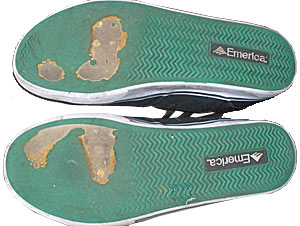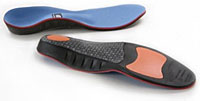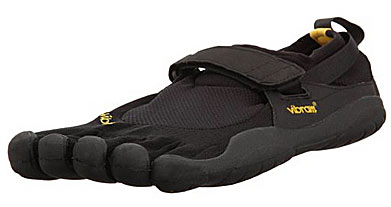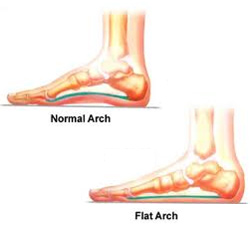- Like
- SHARE
- Digg
- Del
- Tumblr
- VKontakte
- Flattr
- Buffer
- Love This
- Save
- Odnoklassniki
- Meneame
- Blogger
- Amazon
- Yahoo Mail
- Gmail
- AOL
- Newsvine
- HackerNews
- Evernote
- MySpace
- Mail.ru
- Viadeo
- Line
- Comments
- Yummly
- SMS
- Viber
- Telegram
- JOIN
- Skype
- Facebook Messenger
- Kakao
- LiveJournal
- Yammer
- Edgar
- Fintel
- Mix
- Instapaper
- Copy Link
What You Need-to-Know About Overpronation
 What is Overpronation?
What is Overpronation?
Overpronation is a pesky foot problem in which the feet roll excessively inward when you walk or run. Commonly called “flat feet”, overpronation can occur for a couple different reasons; the foot may indeed be flat, lacking an arch, or the arch may be high but collapse too far when being stepped on.
The arch of the foot is like the suspension in a car. If the suspension isn’t working right, it won’t be able to properly distribute impact and the structural integrity of the whole system will be compromised. The same holds true for your feet. They are a site of tremendous impact in the body, “where the rubber meets the road,” so to speak, and need to be functioning optimally to make sure force is properly distributed throughout your tissues.
Overpronation is more of a symptom of larger problems than a problem in and of itself. Muscle imbalances and/or weak connective tissue in the feet and lower legs are the real cause of overpronation and its subsequent issues.
It’s extremely important to optimize the biomechanics of your feet, especially if you are a runner, walker, or athlete of any kind. Keep reading to discover the causes of overpronation, how to find out if you’re an overpronator, the problems caused by overpronation, and tips on how to correct overpronation foot problems.
Normal Biomechanics of the Foot Strike
The normal gait cycle proceeds as follows: as the mid-foot strikes down, the foot pronates slightly, flattening the arch as the foot absorbs impact. As you roll through the big toe, the foot begins to supinate (roll to the outside) as stored energy in the tendons and ligaments propel you forward. As you can see, pronation is a key step in the normal gait cycle, but only in moderation. Excessive pronation is what leads to overpronation foot problems.
What Causes Overpronation?
Overpronation is caused by improper biomechanics of the lower leg. Some muscles are overly tight while others are overly loose. This is referred to as a muscle imbalance, resulting in posture issues throughout the body. Flat feet and knock knees may be co-occurring issues which cause or exacerbate overpronation.
Although overpronation is surprisingly common through all segments of the population, elders and pregnant women are at increased risk.In the aging process, tissue quality begins to degenerate. It’s especially important for elders to engage in strength and balance training to combat the effects of aging. Pregnant women undergo hormonal changes that affect the ligaments in the feet and may cause their arches to flatten, leading to overpronation.
Overpronation causes somewhat of a vicious cycle, feeding on issues it creates. This is known in fitness as the cumulative injury cycle, wherein an issue gets worse with every reiteration due to weakening of the area in question.
How Do I Know if I Overpronate My Feet?
 You can find out if you’re an overpronator at home by checking the soles of your everyday shoes. Are they worn evenly across the ball of the foot, or is the majority of the wear concentrated in one area? If the tread is worn down primarily on the inner surface, you may be an overpronator. Also, if the outer edge of the heel is worn down, this may also be evidence of overpronation. Many overpronators strike down hard on the outside of the heel before rolling the foot inward in an attempt to compensate.
You can find out if you’re an overpronator at home by checking the soles of your everyday shoes. Are they worn evenly across the ball of the foot, or is the majority of the wear concentrated in one area? If the tread is worn down primarily on the inner surface, you may be an overpronator. Also, if the outer edge of the heel is worn down, this may also be evidence of overpronation. Many overpronators strike down hard on the outside of the heel before rolling the foot inward in an attempt to compensate.
Many people discover they are overpronators when they visit the doctor for foot, ankle, knee, hip , and lower back problems. Overpronation throws off the entire movement system of the lower body and may manifest in areas that seem to be upstream.
You can visit a doctor or physical therapist to get help if you suspect you may have overpronation foot problems. Many sports stores and specialty running stores also offer gait analysis to help you discover your strengths and weaknesses.
What Problems are Caused by Overpronation of the Foot?
As stated above, overpronation may be the hidden cause of foot, ankle, knee, hip, and even lower back problems. Overpronation causes misalignment of the movement system, placing abnormal stress on tissues working outside their normal scope of operation.
Overpronation may lead to the following issues:
- Plantar fasciitis, a painful tightening of the connective tissue of the sole of the foot
- Heel spurs, painful outcroppings of bone developing on the overstressed site
- Metatarsalgia, pain and inflammation of the ball of the foot
- Bunions, swelling and abnormal bone growth on the prominence on the outer foot below the big toe
- Shin splints, strain and fatigue in the shin muscles
- Posterior tibial tendonitis, an inflammatory condition affecting the tendon near the inner ankle
And the list goes on. These are just a few of the most common problems often linked to overpronation of the foot.
How to Correct Overpronation Foot Problems / Flat Feet
 A quick fix often prescribed for overpronation is to buy orthotic inserts which provide rigid arch support. These are available over the counter, or can be custom-made by a podiatrist to fit the exact shape of your arch. There is much debate regarding orthotics, with some experts touting them as safe and effective, and others claiming they lead to further degeneration down the line as they provide rigid support in an area meant to be dynamically flexible.
A quick fix often prescribed for overpronation is to buy orthotic inserts which provide rigid arch support. These are available over the counter, or can be custom-made by a podiatrist to fit the exact shape of your arch. There is much debate regarding orthotics, with some experts touting them as safe and effective, and others claiming they lead to further degeneration down the line as they provide rigid support in an area meant to be dynamically flexible.
I am an overpronator myself, and I found my rigid prescription orthotics to do more harm than good, causing foot, knee, and lower back stress. I now wear soft inserts to provide some cushion and support, and find these to be more effective and comfortable. The choice of whether or not to use orthotic supports up to you, and I recommend doing your own research to find out what will best work for you.
Since the root cause of overpronation is muscle imbalances in the legs, the long-term solution is to work on strengthening muscles that are too weak and mobilizing tissues that are too tight. Many experts recommend walking around barefoot as much as possible. This allows more sensory input from all areas of the foot so the foot can dynamically adapt to the terrain. Over time, overpronation symptoms may disappear as weak areas strengthen and tight areas loosen.
 Your choice of everyday footwear is also important in correcting overpronation foot problems. Make sure your everyday shoes are properly supportive and fit correctly. You can buy minimalist footwear to simulate the barefoot effect even in situations which require you to wear shoes. You should also ditch the high heels right away. High heels cause a slew of posture problems and should be reserved for special occasions only.
Your choice of everyday footwear is also important in correcting overpronation foot problems. Make sure your everyday shoes are properly supportive and fit correctly. You can buy minimalist footwear to simulate the barefoot effect even in situations which require you to wear shoes. You should also ditch the high heels right away. High heels cause a slew of posture problems and should be reserved for special occasions only.
You can also perform strengthening and stretching exercises for the feet, ankles, and legs to help your body find balance. Read our page on the Best Foot and Ankle Exercises to learn strengthening exercises, and be sure to check out our Leg Stretches page to learn how to loosen tight tissues in your legs.
Adding yoga practice to your fitness routine may also help correct overpronation foot problems. Not only are you barefoot in yoga practice, but you will perform many moves which challenge your balance. Balance training helps strengthen the arches of the feet.
If you are experiencing mysterious pain in your feet, ankles, or anywhere else, don’t suffer in silence. You don’t have to try to fix it all by yourself, either. See a doctor to find out what’s really going on and what you can do about it.
References
1. Clark, M.A., Lucett, S.C., and Sutton, B.G., (Eds.). (2012). NASM essentials of personal fitness training. Philadelphia: Lippincott Williams & Wilkins.
2. Gangemi, S. (2011). Overpronation is not really your problem. Sock Doc. http://sock-doc.com/2011/05/overpronation/
3. Thistle, S. (2013). Research review corner: Reducing overpronation. Canadian Chiropractor. http://www.canadianchiropractor.ca/content/view/2332/38/
About Mae Barraclough
Mae Barraclough, B.S., NASM-CPT, NASM-CES is a certified personal trainer, corrective exercise specialist, and licensed Zumba Instructor. With her passion for health, fitness, and dance, Mae loves learning all she can and sharing her knowledge with others.

